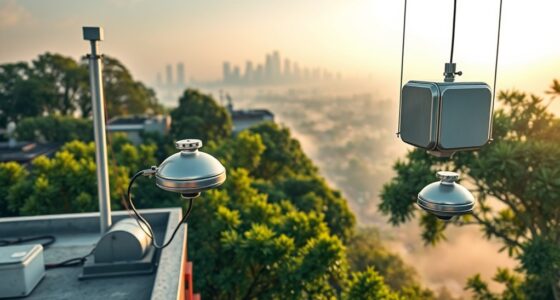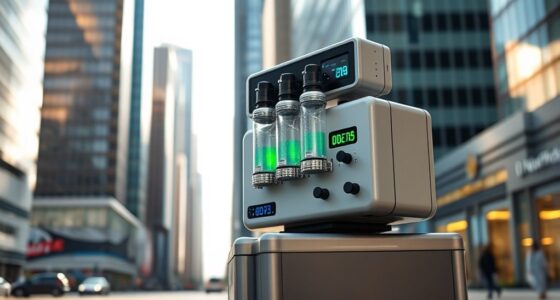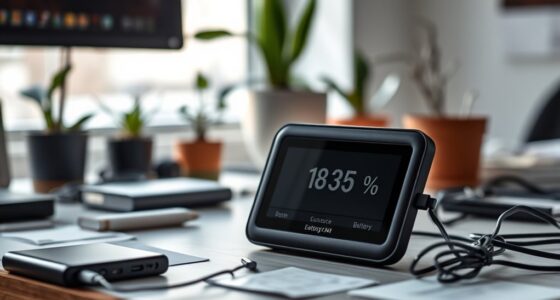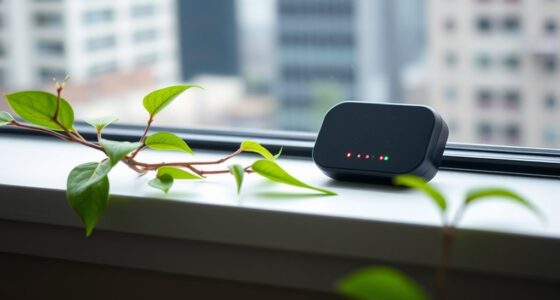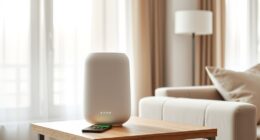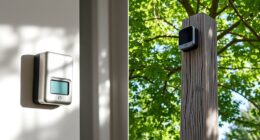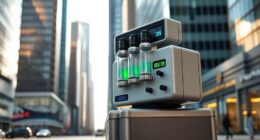To identify sensor drift, regularly compare your sensor readings against a known standard or reference. Look for gradual shifts or deviations over time, which indicate drift. Correct measurement errors by calibrating your sensors with certified reference sources and following proper procedures. Additionally, use data correction techniques like analyzing historical data patterns and applying statistical adjustments. Maintaining this routine helps guarantee accuracy, and staying proactive will reveal more effective strategies to keep your measurements precise.
Key Takeaways
- Regular calibration against certified standards detects and corrects sensor deviations caused by drift.
- Monitoring sensor outputs over time helps identify gradual measurement discrepancies.
- Environmental factors and sensor aging contribute to drift, requiring proactive adjustment strategies.
- Data correction techniques, like statistical analysis, can mitigate measurement errors when calibration isn’t feasible.
- Combining scheduled calibration with ongoing data correction ensures optimal accuracy and prolongs sensor lifespan.
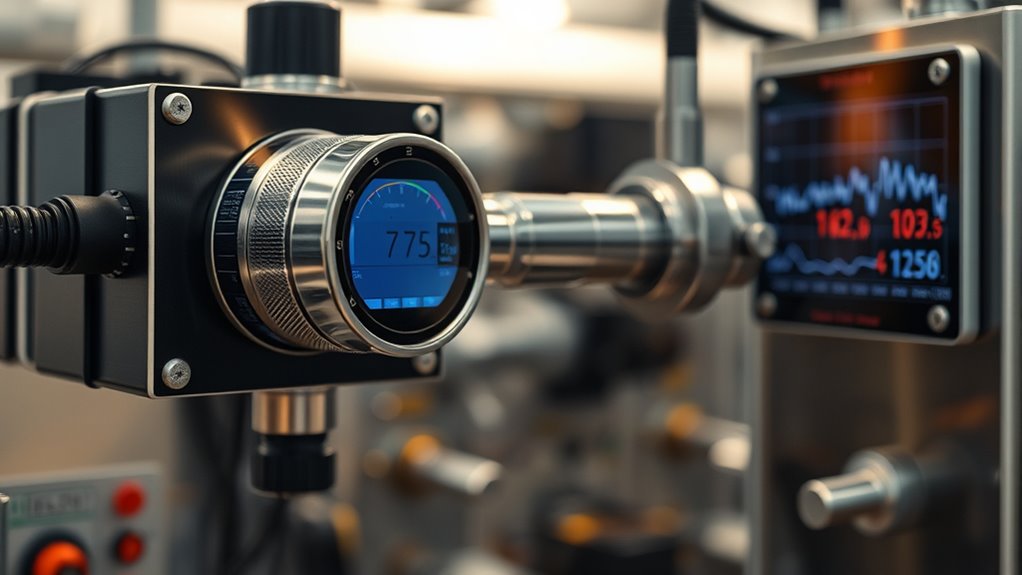
Have you ever wondered why sensor readings sometimes become inaccurate over time? It’s a common issue, and understanding the root causes can help you maintain measurement accuracy. Sensor drift occurs when the sensor’s output gradually shifts away from the true value, often due to aging components, environmental factors, or repeated use. To combat this, you need to implement effective calibration procedures and data correction techniques. These methods are essential for identifying drift early and guaranteeing your data remains reliable.
Sensor drift causes inaccuracies; regular calibration and data correction are essential for reliable measurements.
Calibration procedures are the foundation of accurate measurements. They involve comparing your sensor’s readings against a known standard or reference and making adjustments to align the sensor output with the actual value. Regular calibration, whether scheduled or based on performance indicators, helps detect deviations caused by drift. It’s vital to follow manufacturer guidelines or industry standards to perform these calibrations correctly. For example, in temperature sensors, calibration might mean immersing the sensor in a controlled environment with a certified temperature source and adjusting the sensor output accordingly. Proper calibration practices ensure that your sensor maintains accuracy over its operational life, reducing the impact of drift on your data. Additionally, understanding sensor characteristics can help you better anticipate and address potential issues related to drift.
Alongside calibration, data correction techniques serve as practical tools to address and compensate for drift that has already occurred. These techniques involve analyzing historical data to identify patterns indicative of sensor deterioration. Statistical methods, such as moving averages or regression analysis, can help smooth out anomalies and highlight gradual shifts in readings. Once you recognize a drift trend, applying correction algorithms can restore the data’s integrity. For instance, if a sensor consistently overestimates values by a certain margin, you can subtract a correction factor from future readings. Data correction techniques are especially useful when real-time recalibration isn’t feasible or when sensors are embedded in systems where physical access for calibration is limited.
In practice, combining regular calibration procedures with data correction techniques creates a robust strategy for managing sensor drift. Calibration ensures your sensors are initially accurate, while data correction addresses ongoing or past inaccuracies. This dual approach minimizes errors, improves data quality, and extends the useful life of your sensors. Remember, the key is consistency—regularly scheduled calibrations paired with continuous data analysis will help you catch drift early and apply corrections proactively. Ultimately, keeping a close eye on your sensors and applying these practices will give you confidence in your measurements, helping you make informed decisions based on trustworthy data.
Frequently Asked Questions
How Does Sensor Drift Affect Long-Term Data Accuracy?
Sensor drift can substantially impact your long-term data accuracy by reducing sensor stability over time. As the sensor’s measurements become less reliable, your data may show inaccuracies. To combat this, you need to actively implement drift mitigation techniques, such as regular calibration and maintenance. This helps guarantee your sensors stay stable and provide precise readings, safeguarding the integrity of your long-term data collection efforts.
What Are the Cost Implications of Sensor Drift Correction?
You might think correcting sensor drift is costly, but a thorough cost analysis shows it saves money long-term. The expenses include maintenance costs and calibration, but preventing inaccurate data guarantees better decision-making and reduces operational risks. Investing in early correction minimizes downtime and costly repairs, ultimately lowering your total cost of ownership. So, addressing sensor drift proactively is a smart financial move that protects your data integrity and your budget.
Can Software Algorithms Fully Eliminate Sensor Drift?
Software algorithms can’t fully eliminate sensor drift because of their limitations and accuracy concerns. While advanced algorithms can correct many measurement errors, they often struggle with unpredictable or complex drift patterns. You should understand that software-based solutions improve sensor reliability but may not resolve all issues entirely. Combining algorithms with regular calibration is your best approach to maintain measurement precision and minimize drift-related inaccuracies effectively.
How Often Should Sensors Be Calibrated to Prevent Drift?
You should calibrate your sensors regularly, typically every few months or as recommended by the manufacturer, to effectively prevent drift. Frequent calibration ensures measurement accuracy and minimizes errors caused by sensor drift over time. The exact calibration frequency depends on your sensor type, usage conditions, and required precision. By staying consistent with calibration, you maintain reliable data and extend your sensor’s lifespan, reducing costly errors and guaranteeing peak performance.
Are Certain Sensors More Prone to Drift Than Others?
Yes, some sensor types are more prone to drift, especially those made from less stable materials. For example, sensors with delicate or reactive materials tend to experience more measurement errors over time. You should pay close attention to material stability when selecting sensors, as more stable materials help mitigate drift. Regular calibration and maintenance are essential for sensitive sensor types to ensure accurate data collection and reliable performance.
Conclusion
As you watch the sensor’s readings gently shift over time, it’s clear that understanding drift isn’t just about fixing errors—it’s about catching subtle clues before they become problems. When you identify and correct these measurement deviations early, you prevent costly mistakes and guarantee accuracy. Like noticing the faint flicker of a candle in the dark, recognizing sensor drift keeps your data reliable, guiding your decisions with confidence and precision.


